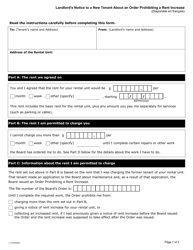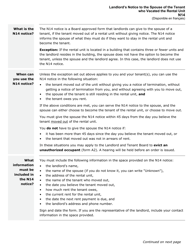Instructions for Form T5 Landlord Gave a Notice of Termination in Bad Faith - Ontario, Canada
The Instructions for Form T5 "Landlord Gave a Notice of Termination in Bad Faith" in Ontario, Canada provide guidance on how tenants can file a complaint against a landlord who has issued a notice of termination in bad faith. This form is used to seek remedies and compensation for wrongful eviction.
The instructions for Form T5, if the landlord gave a notice of termination in bad faith in Ontario, Canada, should be filed by the tenant.
Instructions for Form T5 Landlord Gave a Notice of Termination in Bad Faith - Ontario, Canada - Frequently Asked Questions (FAQ)
Q: What is Form T5?
A: Form T5 is a form used in Ontario, Canada for dealing with tenant and landlord disputes.
Q: What does it mean for a landlord to give a notice of termination in bad faith?
A: When a landlord gives a notice of termination in bad faith, it means that they are terminating the tenancy agreement dishonestly or for reasons that are not valid.
Q: How does a tenant respond to a notice of termination in bad faith?
A: A tenant can respond to a notice of termination in bad faith by filling out and submitting Form T5 to the Landlord and Tenant Board in Ontario.
Q: What information should be included in Form T5?
A: Form T5 should include details about the landlord's actions that are considered a termination in bad faith, as well as any evidence or documentation to support the claim.
Q: What happens after submitting Form T5?
A: After submitting Form T5, the Landlord and Tenant Board will review the complaint and may schedule a hearing to resolve the dispute.
Q: What are the possible outcomes of a hearing regarding a bad faith notice of termination?
A: The possible outcomes of a hearing regarding a bad faith notice of termination include the termination being deemed valid, the termination being invalidated, or other appropriate remedies being ordered by the Landlord and Tenant Board.
Q: Is there a specific time frame for submitting Form T5?
A: There is no specific time frame for submitting Form T5, but it is recommended to do so as soon as possible after receiving a notice of termination in bad faith.


























